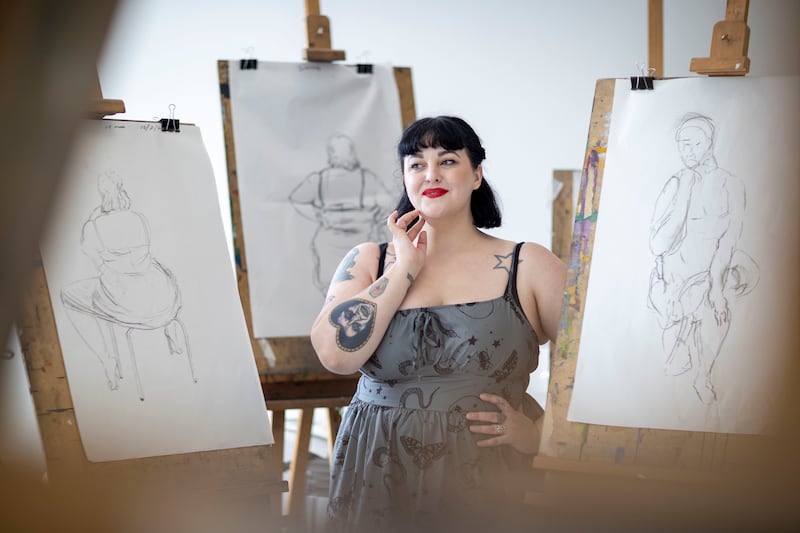I was born in the UK, but my mum is Irish, so we moved back to Ireland and lived in Mayo when I was younger. I went to Australia when I was 18 and came back here for university. I got pregnant about seven years ago and moved to Greystones and this is where I’m based now.
I used to do cabaret and burlesque, and vintage 1950s style pin-up modelling. Early in 2020 I saw a call-out from the Hugh Lane Gallery looking for life models for their drawing classes, and I thought that’s a bit of me, so I just decided to do it. After the pandemic Hugh Lane were like, ‘Hey, we’d love to have you back.’
There are a few different kinds of classes. There’s one during the summer outside for kids. For those classes I wear colourful costumes, or something a little bit different, and I stand in the middle of a big group of kids while they draw me. It’s the same for the Sunday sketching sessions, which is inside the sculpture gallery in the museum. I also do serious art classes with fantastic artists drawing, and I basically go in and pull whatever poses the co-ordinator wants me to do: from dancing poses or more natural poses to strange-shaped poses.
Sometimes I have to hold a pose for a minute, or up to 10 minutes, and sometimes I do an hour straight of one pose and it’s basically just standing as still as you can, and that’s it: standing really still and learning how to meditate. You have to move sometimes, otherwise you faint. I’ve fainted once before because I stood in a weird pose for too long, so that was a big lesson that day.

My job consists of trying to pull as many dynamic poses for these artists so they can get a good idea of the body and anatomy, and of different types of bodies. I’m a bit curvier, so it’s interesting for artists to be able to draw that kind of body. I have a six-year-old son, so the opportunity to stand still and not say anything and not have someone like, “Mum, mum, mum”: it is bliss, I will tell you that.
I tend to do clothed life modelling. I have done seminude, but for Hugh Lane it’s pretty much clothed. There are times where I feel weird: people are analysing my body. I grew up in the late 1990s and 2000s where there was this whole body-image thing, so I’ve still got that in my head sometimes that, like, ‘Oh my God, I’m not the perfect shape’. You just get to the point where you shut it off. I think the meditation [helps]. You turn those voices off. You’re like, I’m here to serve a purpose so people can draw bodies like mine.
The artists do incredible sketches, but when you see drawings from the kids or younger people, and they’ve drawn you so colourfully and pretty, it’s an ‘Oh my God’ moment. It can be a bit of an adrenaline high afterwards. Some of the kids come up and give me their pictures, I have a collection of pictures that people have drawn of me. I usually see all the pictures; in the life drawing classes everyone goes around and looks at each other’s sketches to see what they’ve done, their techniques and what they’ve learned.
When you see yourself from others’ eyes, it can be weird, because people see you a certain way
On a day-to-day basis, where I’m working and I’m looking after my son, I see myself in mum mode, or work mode, and it can be a very clouded version of yourself, in leggings and a baggy hoodie. But then, when you see yourself from others’ eyes, it can be weird, because people see you a certain way. It highlights things about yourself that you never thought would have been interesting to draw, like your legs, lips, or the curve of your back. It’s a really strange sensation but it’s almost empowering at the same time.
When I’m standing there I tell myself, it’s okay: I’ve gone outside of my comfort zone, but look at me. If I can do this – stand in a room full of strangers analysing my body and drawing my body how they see it – I can do anything I want, and face anything that scares me.
In conversation with Ellen O’Donoghue










